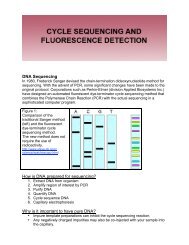DNA Cloning
DNA Cloning
DNA Cloning
Create successful ePaper yourself
Turn your PDF publications into a flip-book with our unique Google optimized e-Paper software.
Page 15<br />
Biol 312 L Molecular Biology Lab<br />
Topic IV: SEPARATING BY ELECTROPHORESIS<br />
In order to characterize <strong>DNA</strong> restriction fragments, verify that restriction<br />
digestions have worked, or to purify restriction fragments, it is necessary to<br />
separate the various sized fragments. An extremely common method to do this is<br />
called gel electrophoresis.<br />
1. Movement of <strong>DNA</strong><br />
<strong>DNA</strong> is negatively charged (due to the phosphate residues on the <strong>DNA</strong><br />
backbone) and as such can be separated in an electrical field. Digested <strong>DNA</strong><br />
samples can be loaded into the wells of an agarose gel with the gel wells situated<br />
by the negative electrode. An electrical field applied across the gel causes the<br />
<strong>DNA</strong> fragments to migrate through the gel matix toward the positive electrode.<br />
The gel matrix acts as a sieve through which smaller <strong>DNA</strong> fragments migrate<br />
faster than larger ones. The migration of <strong>DNA</strong> is inversely proportional to the log<br />
of its size. By loading appropriate <strong>DNA</strong> size standards in the gel, it is possible to<br />
determine the size of <strong>DNA</strong> restriction fragments after staining and photographing<br />
the gel. The concentration of agarose in the gel may be varied to allow resolution<br />
of differing sizes of <strong>DNA</strong> fragments (See Table below).<br />
Table 3.1: Separation of <strong>DNA</strong> in agarose gels.<br />
Percent Agarose in Gel Size range of <strong>DNA</strong> molecules<br />
efficiently separated (kb)<br />
0.6 1.0-20<br />
0.8 0.6-12<br />
1.0 0.4-8<br />
2.0 0.3-6<br />
1.5 0.2-4<br />
Agarose Gel Electrophoresis units (called gel “rigs”) are varied in style but all<br />
have the same basic components (See diagrams below). A detailed explanation<br />
of gel rigs will be given in class.<br />
Figure 3.5: Agarose gel electrophoresis. (photo by S. Dellis)



